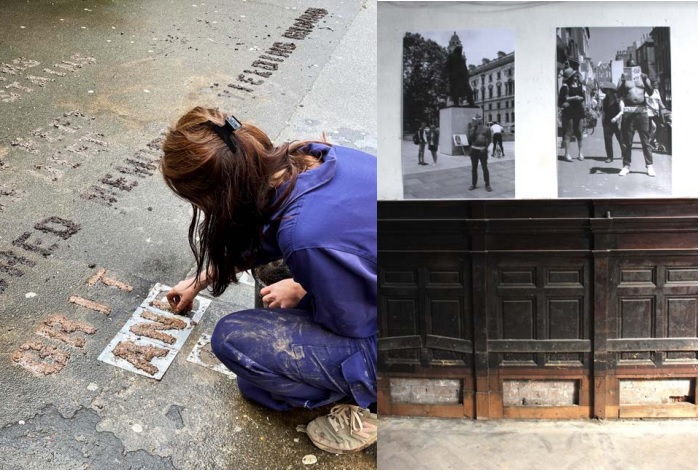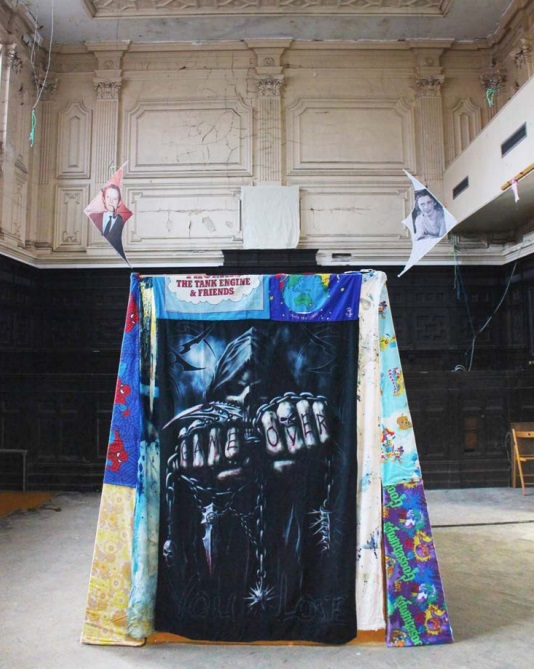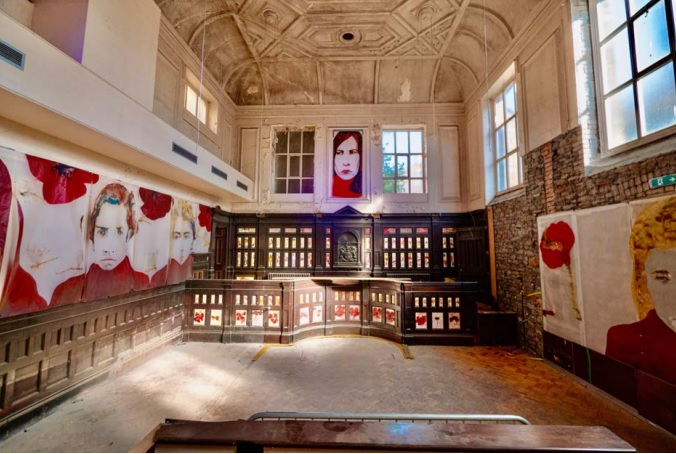|
Curation as
Unstable Monument
Amy Shannon Halliday
Making his way carefully through Bristol’s Arnos Grove cemetery early in
2015 after ankle ligament replacement surgery left him on crutches,
artist Matthew Benington found himself drawn to a precarious grave
marker wrapped in a blue tarp, covered in hazard tape, and surrounded by
scaffolding: “Unstable monument,” it announced. For Benington — who uses
found and inherited materials, assembled fragments, and large-scale
printmaking processes to grapple with questions of history, memory,
identity, and forced displacement (including that of his grandmother
from eastern Germany in the 1940s) — the sign offered a powerful
rejoinder to the rhetoric of fixity, coherence, and stability embedded
in traditional public monuments, institutions, and even notions of the
self.

“Warning: Unstable Monument”, snapshot from Arnos
Grove cemetery inset into an installation by Matthew Benington.
Over time, Unstable Monuments became a framework for thinking
about art-making, self-making, and history-making as fundamentally
contingent, interrelational (and intergenerational) and unfinished.
Working closely with fellow artist Jesse Leroy Smith, Benington has
developed this line of inquiry into a state of curatorial emergence.
Rather than participating in the pristine "white cube” gallery sector,
Smith and Benington have worked with community partners to create a
series of ambitious artist-led projects set in spaces of transition or
precarity: an old warehouse in the ex-industrial mining town of Truro,
Cornwall; a derelict complex of nineteenth-century magistrates courts
and jail cells in Bristol’s Bridewell Street. As artist-curators, the
two are interested in anti-monumental materials and fugitive forms, and
in creating the conditions by which emerging and established artists
might experiment and collaborate, responding to specific sites, and to
each other. The resulting exhibitions unfold dynamically: more than a
little “out of [their] hands” laugh Benington and Smith over a
conversation about their recent Bristol-based project.
The port city of Bristol — where a statue of merchant and slave trader
Edward Colston (1636-1721) was erected in 1895, and famously toppled and
tossed into the river by anti-racism protestors in June of 2020 — is
freighted with the legacies of the past. Like the Colston statue, the
former Magistrates Courts are Grade II listed on the National Historic
Register. The courts have languished, largely empty, since the 1970s,
variously used as a squat, a pop-up rave venue, a laser quest labyrinth.
After years of advocacy, partnership and business-case building, the
courts are set to be transformed into a creative entrepreneurship and
up-skilling hub for marginalized youth. Renovation and restoration are
due to begin in late 2022, but in March and April, Benington and Smith
worked with Creative Youth Network (CYN), the charity spearheading the
transformation, to run artists’ residencies in the space, culminating in
a one-weekend-only exhibition that reverberated well beyond its walls.

Katie Henning, Displace, 2021, public art performance,
Richard Mark Rawlins, Public Intervention. 2020
Approaching the buildings for the exhibition, the first work to catch my
eye was a live performance and ephemeral public artwork by Katie
Hanning. Using hand-made stencils filled in with soil gathered from
significant sites around Bristol, in Displace, Hanning inscribed
the concrete courtyard with words bearing witness to her experience and
encounters with people and places during the process of collecting and
“moving” the earth. Hanning is interested in the invisible barriers that
prevent audiences from engaging with art in traditional institutional
settings. Her work, instead, is deeply informed by movement and
conversation; the carrying of ideas and materials across thresholds. The
outlines of the words are scuffed and occluded by the feet of visitors,
spreading the soil in their wake, but their ghostly traces remain:
“yielding” I read. I think I can make out the words “from where we
came…” I stand for a while, and watch. Hanning was part of an
exhibiting/performing group of art students from the University of Bath
Spa, convened and mentored by Bristol-based artist and educator Young-In
Hong. Henning’s placement at the entrance foregrounded the significance
of live performance and durational media in Unstable Monuments,
as well as the curators’ commitment to young and emerging artists
(another call for artists went out through the Creative Youth Network).
At the same time, as Smith emphasises during our conversation,
mentorship is multidirectional, with many artists working closely
together during the residency to respond to the buildings and to
Bristol, and to the ideas, challenges and experimentation that working
together fomented.
Architecturally and affectively, the building is very clearly divided
between ground-level courthouses and offices (large, airy, full of
natural light) and a series of subterranean cells (small, damp, dark).
Across both, and in the interstitial spaces of stairs and corridors,
several of the artists’ works directly confront the vexed question of
monuments and public memory with deliberately anti-monumental materials
and processes. Richard Mark Rawlins explores the tension between the
invisibility and hyper-visibility/surveillance of the Black body in
public spaces through a series of Public Interventions (2020)
around London. In each performance, the artist stands, bare torsoed —
outside the National Gallery in Trafalgar Square, or with the Winston
Churchill Statue in Parliament Square — and holding in front of his face
a range of texts such as Reni Eddo-Lodge’s Why I'm no Longer Talking
to White People about Race. Performance documentation is installed
as an unassuming series of black and white poster reproductions,
wheat-pasted to a courtroom wall just above the room’s dark wood
panelling: documentation includes an email in which Rawlins writes to
Bristol mayor Marvin Rees about staging one of his interventions on the
empty Colston plinth (the request was denied).
Rawlins’ interventions face Matthew Benington’s Hide (2015).
Though the structure is reminiscent of a child’s blanket fort, the
softness of the exterior gives way to an interior assemblage of large
sealed etching plates. Painstakingly hand-painted with acid-resistant
varnish directly onto each steel plate, building each tonal layer to
create the image, the surface images are derived from family, found, and
location photographs that are part of Benington’s ongoing research into
forced displacement. Focusing primarily on the kinds of vernacular
imagery that families forced to flee carry with them, rather than the
direct representation of conflict or flight, the installation is a
powerful invocation of the lived reality — the fullness, depth,
entanglements, and exquisite detail rendered as etched traces — of each
life impacted by extreme sociopolitical upheaval.

Matthew Benington, Hide, 2011-2018
Marianne Keating’s Landlessness, a dual screen video installation
in a nearby courtroom, is similarly poetic-yet-incisive in its
exploration of migration and diaspora: in this case the recruitment and
transportation of Irish indentured laborers to the plantations of
Jamaica’s north coast between 1835 and 1842. Keating overlays video
footage of localised land- and seascapes (which might otherwise read as
picturesque) with textual traces: fragments of testimony and records
recovered from the National Archives in Ireland, England and Jamaica are
assembled as if in conversation, tracing past and present connections
between Ireland and the Caribbean, routed through British colonialism.
An archival sensibility and attentiveness to materialising,
interrogating, and layering “traces” – the remaining signs, partial and
contingent visual and textual residue of past events – is a strong
undercurrent in Unstable Monuments. Traces link Benington’s
photographic referents (and their transformation, in turn, as etched
marks in Hide, or physical traces of the dark Bristol cells
brought to light through cyanotype processes in The Architecture of
Enclosure 01) to Keating’s videos, Hanning’s scattered earth, and
James Hankey’s quietly profound Dave Was. In the 36-page kettle
stitch book, Hankey transcribes and archives the messages and musings,
profanities and provocations he found on benches and walls, on the
dividing panels between cells, seating areas and toilets during his
residency: an insistence on presence in the face of prison’s rough
poetry of erasure.

Marianne Keating, Landlessness, 2017-2022
Several works in Unstable Monuments were made on site. Laura Robertson’s
massive sculpture, Body Everted, was made from construction
insulation (a fundamentally liminal material) draped, folded, assembled
and augmented around a wooden scaffold in a small cell, its softness and
organic pliability turning the language of the monument inside out. As
work took form in the space, so other artists responded in performance.
Lily Serendipity, for example, wove her wandering way around Body
Everted in her piece, Unmasking, while Antonia Purdie’s
choreography-as-lifeblood seeped from (and back into) the fluid handling
and crimson palette of Jesse Leroy Smith’s Pollinators
installation. Callum McCutcheon, whose practice is a means of exploring
and mediating conscious and subconscious mental states, spent days
translating his affective experience of the cells (anxiety, uncertainty,
alienation, scattered attention) into a multi-media installation that
was utterly mesmerizing. Reverberating sound, sculpture, wall drawing,
and found objects read as a kind of emotional notation or set of jarring
frequencies, the disparate elements engulfed by video projections of
tumultuous waves crashing over, through, and between cells.

Laura Robertson, Body Everted, 2022
 
Callum McCutcheon installation view, Antonia
Purdie, Unmasking
Local artist Orian had previously been experimenting with carving and
painting wooden skittles but, through his time in residency and in
discussion with other artists, developed this work into a large-scale
installation. Skittles is a historical lawn game and target sport that
has been played for centuries in England in public houses and clubs and
backyards. Taking on this seemingly benign game, and with it ideas of
the “innocence” of childhood, Orian’s skittles are shaped by strong
mental references from his own childhood: comics, popular music, and the
casual racism of Enid Blyton’s children’s books (exported to the
colonies where I, as a white South African, grew up with them too). The
artist takes aim at the powerful hold of early representations and
playground encounters on our racial and social imaginations: the work is
all the more powerful for its positioning in front of a judge’s seat in
a court that may well have been involved in juvenile sentencing.

Orian: ‘Eat,Pray,Clean, Butterfly Effect, ‘Effigy,
Music is the Answer, Hard Target, Skit Skull, Foolish little…,‘Fucking
Exit…,I was Born to Fight, Inside Out, Not For Sale, Skittle Me
Sweet(nfs), An Eye…, Since Power is your God(nfs’. 2021-22
Many works made on site during the residency or installation period were
also unmade during the process of public exhibition. Set in a small,
sun-drenched office between courtrooms, Alison Larkman’s chair
installation, for example, invited visitors to sit, enthroned. Yet each
use strained the fragile vellum seat, stitched from fragments and
stretched taut across the wooden frame, until it gave way. Meanwhile
Ling Ho’s haunting clay figures — their heads formed into loudspeakers
as if an embodiment of protest, assertion, or authority — slowly
dissolved over the course of the weekend, the unfired clay subject to a
constant overhead drip, the water undermining its structural integrity.
 
Alison Larkman
Fragile Skin and Ling Ho Untitled
Given the imminent renovation of the building, as well as its place on
the National Historic Register, artists were not allowed to make any new
holes or add any new fixtures to the walls, a set of aesthetic and
curatorial constraints that heightened a sensitivity to site. Jesse
Leroy Smith’s response was especially striking, measuring out each niche
and negative space in an entire courtroom’s austere wooden panelling and
filling the magistrate’s box with vibrant images of pollinators – birds,
bees, bats, and flowers – that offer a surge of imaginative possibility
and wonder just barely contained by the edifice’s edges. On the three
walls facing and adjacent to the magistrate’s box, Smith presents an
elegiac series of thirteen large-scale portraits, devised and painted in
situ. Operating simultaneously as a personal pantheon, a jury of peers,
and a freighted Last Supper, Gil Scott Heron, James Baldwin, Diane Arbus,
and Vivianne Maier bear witness alongside Raghbir Singh, the first
non-white bus conductor after Bristol’s 1963 Bus Boycott (one of
Britain’s first black-led campaigns for racial justice), and an unnamed
Romani boy killed during the Holocaust (and whose image at the Berlin
Holocaust Museum seared itself into the artist’s consciousness). The
artist’s son, collaborator Matthew Benington, and Creative Youth Network
artist Lucia Harry, whose insights deeply influenced Smith’s thinking
about the Unstable Monuments project, appear, too, among these cultural
icons, looming equally large in the artist’s mind. Painted in oil on
tracing paper, the large substrate floated and buckled in the damp, and
was translucent in the morning sun: the scrim of peeling walls breathed
through the portraits’ thin surfaces.

Leroy Smith Pollinators
As I left the exhibition, I climbed back up the stairs from the cells
and decided to wander the upper halls one more time – small offices and
hallways seemed to elude and surprise me at each turn. Somehow, I had
missed a room with peeling walls, small pod and seed-like sculptures
laid on unobtrusive shelves, and a square cage set on the floor. It was
filled with what looked to be massive cowrie shells with printed indigo
words: DERIVATIVES. SUB-PRIME. HUMAN CAPITAL. Closer inspection revealed
the works to be ceramic transferware, the blue and white motif
reminiscent of the popular trade in transfer wares in the late 19th and
early 20th centuries. With their lustrous decorative surfaces and
“exotic” associations with hand-painted Chinese porcelain, the mostly
Staffordshire-made ceramics became increasingly popular in the United
States. Often, these ceramics featured scenes of “quintessential”
American landscapes and historical accounts, participating powerfully in
the construction and circulation of the country’s heroic (and
exclusionary) founding narrative. Dan Pyne’s replacement of these
popular images with the resurgent heroes of contemporary capitalism on
shapes associated with early modes of currency and exchange seems to
suggest that money – which so often bears the official imprint of a
nation’s ongoing self-construction (its national heroes or architectural
triumphs) – has always been a form of monument, a monumental form.1)
Pyne’s title, It’s just business, don’t take it personally, could act
equally as epigraph to the standard apologia for the statue of
“merchant” Edward Colston… MORAL HAZARD, reads another ceramic cowrie.
It is in contrast to this sort of systemic, pecuniary context that
Unstable Monuments as a model for artist-led, community-partnered,
extra-institutional curating shines most brightly: the exhibition as
provocation; as process; as promissory note for further elaboration. In
October, following months of uncertainty over the future of the Courts
after the Bristol City Council denied the final £700,000 it had pledged
to the Creative Youth Network for its renovation (potentially
jeopardising the almost £5.5 million in match funding already secured),
renovation began in earnest. Images surfaced yesterday of the demolition
of the east entrance, making room for a new, fully accessible entryway:
a newly unstable edifice, poised for possibility.
1) African-American artist Nari Ward recently made the
remark in an interview on the Art Angle podcast that money is our
“portable monument,” but is based on a particular (exclusionary)
history.
'Unstable Monuments' was in Bristol
between 8.4.22 & 13.4.22
26.3.23 |











